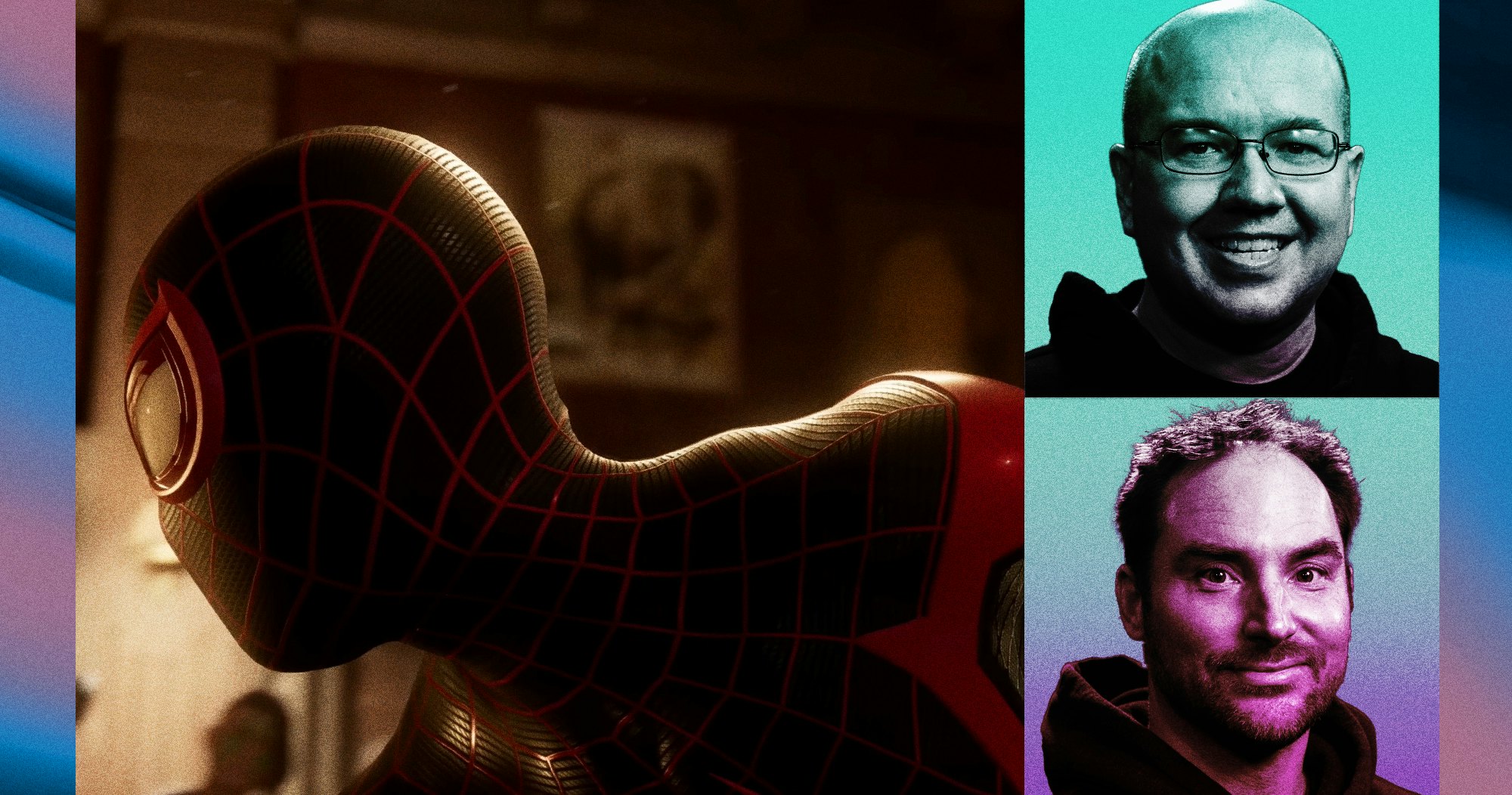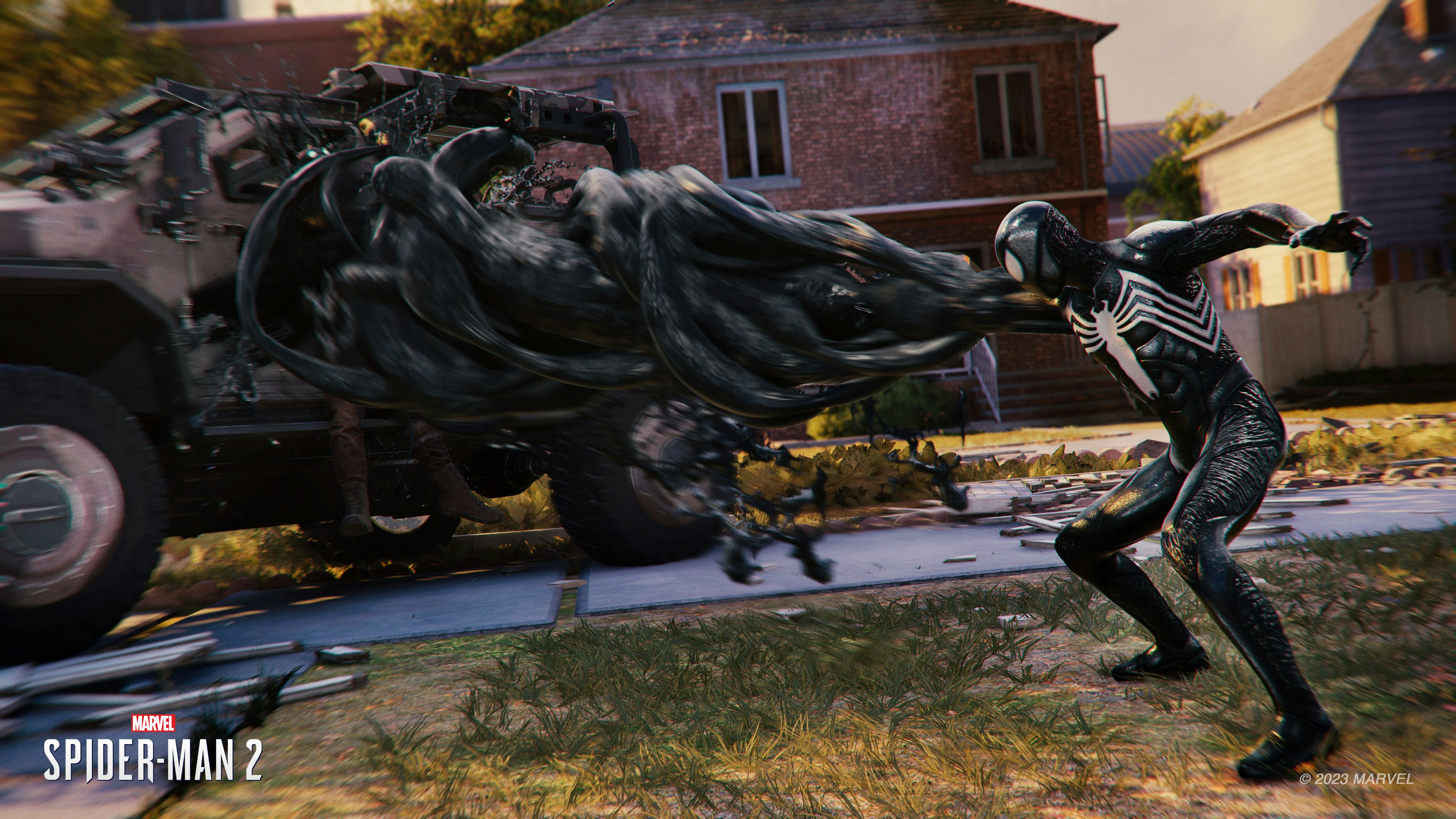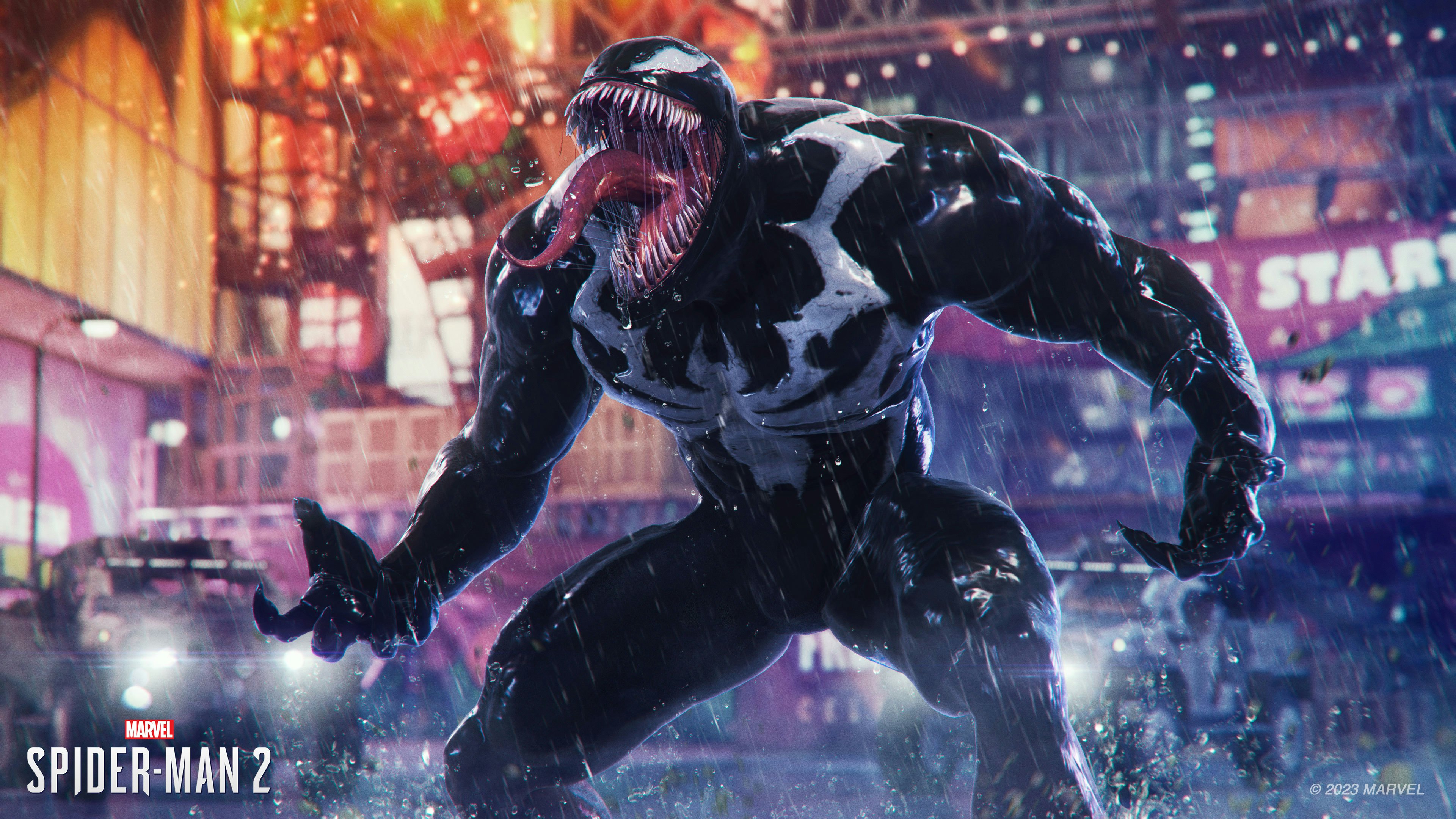
Imagine your old college buddy invites himself to couch-surf at your place for a weekend and never leaves. Only in this scenario, he’s actually an alien parasite and the couch is your body. This is Venom, Peter Parker’s most iconic frenemy.
With the help of the ooey-gooey alien symbiote, Marvel’s Spider-Man 2, out October 20 from Insomniac Games, sees Peter and Miles Morales team up to take down a host of baddies. Only this time around, Peter is… different. The symbiote bonds to him, making Peter stronger than ever, while dramatically altering his personality. His abilities shift from the Thiwp! of a friendly neighborhood web-slinger to the tentacular belches of a deep-sea squid.
“In combat, how Peter's able to leverage those symbiote abilities is really about the transformation. He isn’t just leading with a fist. He's got tentacles, and you can stick enemies to the wall, you can grab a group of enemies and launch them,” game director Ryan Smith says of Peter’s spiffy new tendrils. “It’s an opportunity for putting power out into the gameplay space a little bit differently than we would've done before, by interacting with more enemies.”

Insomniac cut its teeth developing a shooter for the doomed Panasonic 3DO in the mid-’90s. They later developed the successful Spyro and Ratchet & Clank franchises for PlayStation consoles. Spider-Man 2 marks the studio’s third foray into the Spider-verse — Insomniac was acquired by Sony back in 2019, a year after the launch of the first Spider-Man on PS4 and a year before the 2020 sidequel Miles Morales launched alongside the PS5. Bringing the symbiote into the fold allows Insomniac to riff on its hugely successful webslinging formula.
“There's a reason the previous games open up with swinging right away,” creative director Bryan Intihar says. “That's the ultimate fantasy. One of the things we set out to do from day one was honor the fact that being Spider-Man is such a fantasy for so many people. They say anybody can wear the mask, but we want anybody to wear the mask and be good at wearing the mask at the same time. The barrier of entry should be pretty low.”

That ultimate fantasy wouldn’t be complete without a heaping helping of spiffy new Spidey gadgets. The goal here is for players to tinker around with all the new gear and craft their own unique version of the Marvel hero.
“If you go back to the gameplay reveal that we did, the Miles section, when he's sneaking around the fish market, he creates a web line. Then he throws a new gadget out called the web grabber. It brings all the enemies together, smashes them together. And that sets him up to do a big lightning, ground-pound move that he does. That's that sandbox nature of taking all these toys and letting people try them out,” Intihar says. “We just want players to improvise with the experience, whether it's Ratchet & Clank, whether it’s Resistance, and now Spider-Man.”
Spider-Man 2 probably isn’t the first game you’d think of as having “sandbox” elements. The most obvious examples of the genre have more of a building focus, like Minecraft, Roblox, and Fortnite’s creative mode. All three have been enormous successes over the last decade, and in recent years we’ve started to see other developers dabble in elements of the genre. So far in 2023, Nintendo’s The Legend of Zelda: Tears of the Kingdom and Bethesda’s Starfield both riff on sandbox design elements by foregrounding player creativity and expression.
“That’s a trend I'm seeing so much,” Intihar says. “I'll never be as creative as some of the videos I've seen [of Breath of the Wild player creations], but it's such a compliment to Nintendo that the systems and the world they've created are so deep that they allow players to truly let their imaginations run wild. I think you're only going to see that increase over time.”
“We just want players to improvise with the experience.”
This industry-wide shift toward more customizable experiences can also be seen through recent innovations in accessible design, which allows people with sensory, physical, or cognitive differences greater control over how they interact with a game. PlayStation has been a leader in accessibility with games like The Last of Us Part II, Horizon Forbidden West, and Insomniac’s dimension-hopping platformer, 2021’s Ratchet & Clank: Rift Apart.
For Smith, making Insomniac’s games more accessible meant embracing an iterative approach to features that can be gradually improved from one project to the next, instead of striving to get everything right the first time.
“One of the most powerful lessons for me, at least on the first Spider-Man, was that we didn’t have to have the perfect version of accessibility features. They just had to open the door a bit more. As developers, we want it to be perfect. But you can't let that stop you from doing something that will get more people playing,” Smith says.
“I'm sitting here in awe — and also jealous! — of what they've been able to create.”
But making a game people love is about more than meticulous design — it’s about telling a story players will carry with them long after putting down their controllers. Insomniac’s Spider-Man games nimbly navigate a tricky balancing act between open-world freedom and compelling stories. That’s the product of a deliberate effort to make every activity feel meaningful, no matter how small.
“One of our pillars for Spider-Man 2 was making sure there's a great narrative and payoff in anything we did,” Intihar says. “The more we can include a narrative that people can connect to, it takes away from the game feeling like a checklist.”
Speaking of checklists and all things bureaucratic, an outsider looking in might imagine that working with Marvel on a Spider-Man video game would present all sorts of logistical hurdles, forbidden plot points, and other restrictions. But Intihar says the relationship between Insomniac and Marvel is far more collaborative than you might expect.
“They're not just Marvel, they're friends. And that has really helped through the tougher times of trying to figure out a story moment, or what we want to do with a certain character,” he says. “In the final stretch of Spider-Man 1, we were trying to figure out how to make the fight at the end even better. And someone had the idea of Pete creating a suit based on Otto’s stuff. A lot of that came from our collaboration with Marvel.”
This harmonious partnership isn’t going anywhere. Back in September 2021, Insomniac revealed its next project after Spider-Man 2 is Marvel’s Wolverine, inspired by the adamantium-clawed mutant. While the team is keeping their lips zipped about the upcoming X-Men game, Intihar and Smith did offer a glimpse at the kinds of innovations they’re hoping to see from story-driven games in the years ahead. And they’re a bit more old-school and analog than you might expect from one of the world’s most revered game studios.
Smith is looking ahead to single-player experiences that feel more connected and collaborative — not unlike the asynchronous multiplayer elements of 2019’s eerily prescient pandemic allegory, Death Stranding.
“I would love for us to find a way to get that sense of connection to the community, whether it's sharing photos or just little ways to leave bonuses for friends,” Smith says.
“We didn’t have to have the perfect version of accessibility features. They just had to open the door a bit more.”
Intihar, meanwhile, hopes to see riskier stories that are willing to embrace potentially divisive topics, like politics and religion.
“I’m wondering how games are going to touch on topics that we shied away from over the years, because the topic was quote-unquote ‘controversial,’ or something we don’t talk about,” Intihar says. “We're seeing more and more games tackle topics and themes that we wouldn't have done 10 years ago. And I hope that only increases.”
Insomniac’s first Spider-Man came out during a particularly stacked year for games and was nominated for 2018’s game of the year alongside modern classics like Red Dead Redemption 2, Celeste, and (that year’s victor) God of War. And the sequel will be going up against another crop of bangers like Hi-Fi Rush, The Legend of Zelda: Tears of the Kingdom, and Baldur’s Gate 3.

Are Intihar and Smith envious of all those huge successes over the last several months? Maybe a little. But they’re convinced that a rising tide lifts all boats. In his “23, I think, or 24” years in the industry, Intihar says he hadn’t seen anything quite like it before.
“The amount of games that are getting these great review scores ... it's incredible. There are a lot of talented freaking developers out there and they're doing some really cool stuff. I'm sitting here in awe — and also jealous! — of what they've been able to create,” Intihar tells Inverse. “Having a lot of great games only makes this industry stronger. It's not something to be fearful of, it's something to be proud of. It's only going to make us, our games, and any games that come out in 2024 and 2025 that much better.”







